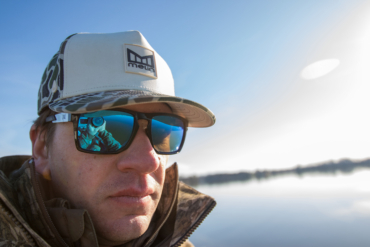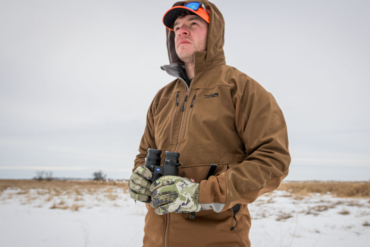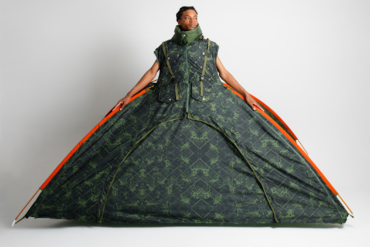A startup brand, OROS stands apart in the world of outerwear with its aerogel-insulated jackets. We put its Orion parka to a test on a zero-degree day.
Aerogel is the lightest, most insulating synthetic material yet developed. Made of about 98-percent air, it weighs just a fraction more than the atmosphere, according to its maker. Sounds like ideal jacket insulation, right?

But its use in apparel is hindered by its fragile nature. Some aerogel products are solid, rigid, dry materials that can shatter like glass. It also tends to catastrophically dissolve in water, a problem that can be addressed through chemistry and packaging.
It’s been used in outdoor jackets in the past but to limited success.
OROS overcame these shortcomings with what it calls Solarcore aerogel. This iteration, created for the jacket, is flexible, thin, and very warm.
The brand raised $360,000 on its Kickstarter campaign for the jacket, which was marketed as being made with “NASA-inspired” insulation.
It uses this insulation in the Orion Series jacket ($399), now available for sale for $288. I tossed it on to face the coldest ski morning of the year so far.
Tested: OROS Orion Aerogel Jacket
The weather at Copper Mountain was still, partly cloudy, and bitter cold at just above zero degrees F.
I picked up the OROS Orion. My first impression was that it weighs a lot. Even though aerogel is a light insulator, this is a heavy jacket.
The size medium I tested weighed a hefty 3.5 pounds on my scale — that’s at least a full pound heavier than almost every winter jacket in my closet (there are a lot).
I zipped it up and got on the chairlift. With a cold breeze on my face, I shivered and tried to zip up the jacket past my chin.

The zipper stopped at a bend under my chin. Like many ski jackets, this one was hard to close all the way while sitting on a chairlift.
Once closed, it sat under my chin. It was difficult to nuzzle my face under the snug collar.
But the rest of my upper body felt warm, as I would expect with a heavy winter jacket.
Hopping off the lift and making turns, the jacket was comfortable and allowed me to move unimpeded. As with most quality jackets designed for serious cold, I was protected from the bitter cold wind of skiing down a mountain at 30 miles per hour.
Review: OROS Orion Aerogel Jacket
The Orion is a nice jacket. But if I didn’t know it contained the newfangled aerogel, I’d peg it as a decent mid-range ski parka with a few limitations.
On the plus side:
The pockets are good-sized and well placed. I fit lunch and a water bottle into two large pockets easily. It has six pockets total.
The jacket has pit zips, which are fair-sized. These are key to dumping heat and moisture, and work as intended.
It’s warm. On a bitterly cold day, it kept me comfortable. But despite its “space-age” insulation, the jacket doesn’t seem noticeably warmer than other high-quality ski pieces I own.
The insulation is thin. The Orion, using similar insulation as space suits, achieves warmth in a thin layer compared to traditional insulations like down or fleece.
Neutral (still unknown):
Breathability. I tested the jacket in zero-degree weather, and thus breathability was difficult to assess. Past aerogel jackets have suffered from breathability issues, as the material was required to be sealed within a membrane. I will report back on the OROS after more extensive testing this winter.

The large hood is (barely) helmet-compatible. But I had a hard time keeping it up over my helmet. The design does not easily cinch the helmet securely around a ski helmet, a critical flaw in my opinion.
On the downside:
It’s a one-piece jacket, meaning it’s only good for very cold weather. There’s no way to remove the heavy insulation for warmer days or use the shell (or insulation) alone. This is common among ski jackets, and not a knock against OROS, but something consumers should consider. I tend to prefer a shell worn over insulating layers that can be removed or added for changing conditions.
The zippers are small, mid-quality SBS models. While water-resistant, it’s an OK zipper, but not great. This is important in a ski jacket, where users must open and close the zipper regularly one-handed. I’m worried about the durability of the small teeth. It doesn’t match up to the industry-standard YKK zippers found on most jackets of this price range.
It’s really heavy, even for a parka style. It weighs more than any other comparable jacket in my closet. This won’t matter much for downhill skiing. It’s a big deal for skinning uphill, snowshoeing, or hiking. It’s worth noting this jacket is also not at all compressible and will take up lots of room in a pack.
Finally, it has a thumb-loop cut into the cuff to hold it around the hand. I found this super uncomfortable, almost painful, and hard not to use. When pulling on the jacket, the thumb loop is hard to avoid, and it put a ton of pressure on the webbing between my thumb and first finger. If I wear the jacket much more, I’ll cut it with scissors first.
Aerogel Jacket: A Decent Start
The OROS jacket has a few flaws, but it is a good beginning for a startup brand. For those looking for a warm jacket to walk around the city or even small jaunts into the winter woods or a little downhill skiing, it should function fine.

But for anyone who needs serious technical equipment for big mountains and all-day winter adventures, it falls short.
It weighs too much. The zippers cut corners. The hood does not easily work with a helmet. It has limited versatility.
These are traits the brand needs to work on in its next iteration if it wants to be taken seriously by outdoors enthusiasts beyond the Kickstarter realm.
But the jacket is made from good materials, has good stitching, and is attractive. OROS is on the right track, but its product still needs refinement.







